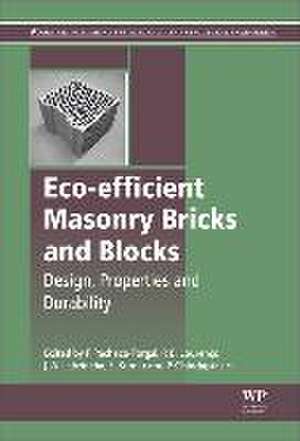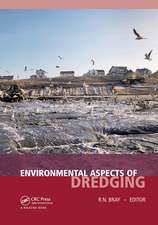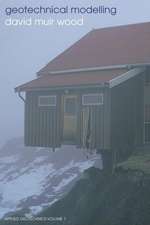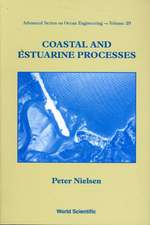Eco-efficient Masonry Bricks and Blocks: Design, Properties and Durability: Woodhead Publishing Series in Civil and Structural Engineering
Editat de Fernando Pacheco-Torgal, Paulo B. Lourenco, Joao Labrincha, Prinya Chindaprasirt, S. Kumaren Limba Engleză Hardback – 4 dec 2014
This book provides an up-to-date state-of-the-art review on the eco-efficiency of masonry units, particular emphasis is placed on the design, properties, performance, durability and LCA of these materials. Since masonry units are also an excellent way to reuse bulk industrial waste the book will be important in the context of the Revised Waste Framework Directive 2008/98/EC which states that the minimum reuse and recycling targets for construction and demolition waste (CDW) should be at least 70% by 2020. On the 9th of March 2011 the European Union approved the Regulation (EU) 305/2011, known as the Construction Products Regulation (CPR) and it will be enforced after the 1st of July 2013. The future commercialization of construction materials in Europe makes their environmental assessment mandatory meaning that more information related to the environmental performance of building materials is much needed.
- Provides an authoritative guide to the eco-efficiency of masonry units
- Examines the reuse of waste materials
- Covers a range of materials including, clay, cement, earth and pumice
Din seria Woodhead Publishing Series in Civil and Structural Engineering
- 24%
 Preț: 1419.36 lei
Preț: 1419.36 lei - 9%
 Preț: 931.67 lei
Preț: 931.67 lei - 29%
 Preț: 1333.83 lei
Preț: 1333.83 lei - 29%
 Preț: 1196.79 lei
Preț: 1196.79 lei - 29%
 Preț: 1074.37 lei
Preț: 1074.37 lei - 9%
 Preț: 805.54 lei
Preț: 805.54 lei - 29%
 Preț: 1329.07 lei
Preț: 1329.07 lei - 31%
 Preț: 1008.03 lei
Preț: 1008.03 lei - 9%
 Preț: 1008.22 lei
Preț: 1008.22 lei - 27%
 Preț: 780.87 lei
Preț: 780.87 lei - 39%
 Preț: 858.21 lei
Preț: 858.21 lei - 29%
 Preț: 1333.96 lei
Preț: 1333.96 lei - 29%
 Preț: 1195.75 lei
Preț: 1195.75 lei - 9%
 Preț: 1333.91 lei
Preț: 1333.91 lei - 28%
 Preț: 1140.27 lei
Preț: 1140.27 lei - 37%
 Preț: 683.84 lei
Preț: 683.84 lei - 9%
 Preț: 879.75 lei
Preț: 879.75 lei - 23%
 Preț: 1134.17 lei
Preț: 1134.17 lei - 24%
 Preț: 922.75 lei
Preț: 922.75 lei - 39%
 Preț: 1475.52 lei
Preț: 1475.52 lei - 9%
 Preț: 900.78 lei
Preț: 900.78 lei - 39%
 Preț: 901.38 lei
Preț: 901.38 lei - 23%
 Preț: 1516.67 lei
Preț: 1516.67 lei - 9%
 Preț: 1153.90 lei
Preț: 1153.90 lei - 23%
 Preț: 1083.03 lei
Preț: 1083.03 lei - 24%
 Preț: 874.91 lei
Preț: 874.91 lei - 24%
 Preț: 1048.97 lei
Preț: 1048.97 lei - 9%
 Preț: 1107.70 lei
Preț: 1107.70 lei - 9%
 Preț: 1187.11 lei
Preț: 1187.11 lei - 23%
 Preț: 1129.24 lei
Preț: 1129.24 lei - 24%
 Preț: 986.08 lei
Preț: 986.08 lei - 28%
 Preț: 1285.96 lei
Preț: 1285.96 lei - 29%
 Preț: 1300.03 lei
Preț: 1300.03 lei - 29%
 Preț: 1330.37 lei
Preț: 1330.37 lei - 9%
 Preț: 746.20 lei
Preț: 746.20 lei - 37%
 Preț: 683.94 lei
Preț: 683.94 lei - 23%
 Preț: 1202.24 lei
Preț: 1202.24 lei - 29%
 Preț: 1481.04 lei
Preț: 1481.04 lei - 9%
 Preț: 812.56 lei
Preț: 812.56 lei - 24%
 Preț: 1186.01 lei
Preț: 1186.01 lei - 9%
 Preț: 1357.19 lei
Preț: 1357.19 lei - 9%
 Preț: 842.75 lei
Preț: 842.75 lei - 23%
 Preț: 1416.56 lei
Preț: 1416.56 lei - 39%
 Preț: 1189.20 lei
Preț: 1189.20 lei - 24%
 Preț: 1162.19 lei
Preț: 1162.19 lei - 24%
 Preț: 1007.79 lei
Preț: 1007.79 lei - 9%
 Preț: 1007.35 lei
Preț: 1007.35 lei
Preț: 1280.31 lei
Preț vechi: 1793.99 lei
-29% Nou
Puncte Express: 1920
Preț estimativ în valută:
245.02€ • 266.05$ • 205.81£
245.02€ • 266.05$ • 205.81£
Carte tipărită la comandă
Livrare economică 15-29 aprilie
Preluare comenzi: 021 569.72.76
Specificații
ISBN-13: 9781782423058
ISBN-10: 1782423052
Pagini: 548
Dimensiuni: 152 x 229 x 38 mm
Editura: ELSEVIER SCIENCE
Seria Woodhead Publishing Series in Civil and Structural Engineering
ISBN-10: 1782423052
Pagini: 548
Dimensiuni: 152 x 229 x 38 mm
Editura: ELSEVIER SCIENCE
Seria Woodhead Publishing Series in Civil and Structural Engineering
Cuprins
1. Introductionto eco-efficient masonry bricks and blocks
PART I – DESIGN, PROPERTIES AND THERMAL PERFORMANCE OF LARGE AND HIGHLY PERFORATED FIRED-CLAY MASONRY BRICKS
2. The design and mechanical performance of large and highly perforated fired masonry bricks
3. Influence of large and highly perforated fired clay bricks in the improvement of the equivalent thermal transmittance of single-leaf masonry walls
4. Traditional fired clay bricks versus large and highly perforated fired clay bricks masonry: Influence on buildings thermal performance
PART II – THE DESIGN, PROPERTIES AND DURABILITY OF FIRED-CLAY MASONRY BRICKS CONTAINING INDUSTRIAL WASTES
5. The properties and durability of clay-fly ash-based fired masonry bricks
6. Types of waste, properties and durability of pore forming waste-based fired masonry bricks
7. Types of waste, properties and durability of toxic waste-based fired masonry bricks
PART III – THE DESIGN, PROPERTIES AND DURABILITY OF PORTLAND CEMENT CONCRETE MASONRY BLOCKS
8. The properties and durability of high pozzolanic industrial by-produts content concrete masonry blocks
9. The properties and durability of autoclaved aerated concrete masonry blocks
10. The design, properties and performance of concrete masonry blocks with PCMs
11. The design, properties and performance of shape optimized masonry blocks
PART IV – THE DESIGN, PROPERTIES AND DURABILITY OF GEOPOLYMERIC MASONRY BLOCKS
12. The properties and durability of fly-ash based geopolymeric masonry blocks
13. The properties and durability of mine tailings-based geopolymeric masonry blocks
14. The properties and performance of red-mud based geopolymeric masonry blocks
15. Design and properties of fly ash, ground granulated blast furnace slag, silica fume and metakaolin geopolymeric based masonry blocks.
PART V – THE PROPERTIES AND DURABILITY OF EARTH-BASED MASONRY BLOCKS
16. The properties and durability of adobe earth-based masonry blocks
17. The properties of compressed earth-based masonry blocks
18. The durability of compressed earth-based masonry blocks
PART VI – TOPOLOGY OPTIMIZATION AND ENVIRONMENTAL PERFORMANCE
19. Topology optimization for the development of eco-efficient masonry units
20. Environmental performance and energy assessment of fired clay brick masonry
21. Assessment of the energy and carbon embodied in straw and clay masonry blocks
22. Earth-block versus sandcrete block houses: Embodied energy and CO2 analysis
PART I – DESIGN, PROPERTIES AND THERMAL PERFORMANCE OF LARGE AND HIGHLY PERFORATED FIRED-CLAY MASONRY BRICKS
2. The design and mechanical performance of large and highly perforated fired masonry bricks
3. Influence of large and highly perforated fired clay bricks in the improvement of the equivalent thermal transmittance of single-leaf masonry walls
4. Traditional fired clay bricks versus large and highly perforated fired clay bricks masonry: Influence on buildings thermal performance
PART II – THE DESIGN, PROPERTIES AND DURABILITY OF FIRED-CLAY MASONRY BRICKS CONTAINING INDUSTRIAL WASTES
5. The properties and durability of clay-fly ash-based fired masonry bricks
6. Types of waste, properties and durability of pore forming waste-based fired masonry bricks
7. Types of waste, properties and durability of toxic waste-based fired masonry bricks
PART III – THE DESIGN, PROPERTIES AND DURABILITY OF PORTLAND CEMENT CONCRETE MASONRY BLOCKS
8. The properties and durability of high pozzolanic industrial by-produts content concrete masonry blocks
9. The properties and durability of autoclaved aerated concrete masonry blocks
10. The design, properties and performance of concrete masonry blocks with PCMs
11. The design, properties and performance of shape optimized masonry blocks
PART IV – THE DESIGN, PROPERTIES AND DURABILITY OF GEOPOLYMERIC MASONRY BLOCKS
12. The properties and durability of fly-ash based geopolymeric masonry blocks
13. The properties and durability of mine tailings-based geopolymeric masonry blocks
14. The properties and performance of red-mud based geopolymeric masonry blocks
15. Design and properties of fly ash, ground granulated blast furnace slag, silica fume and metakaolin geopolymeric based masonry blocks.
PART V – THE PROPERTIES AND DURABILITY OF EARTH-BASED MASONRY BLOCKS
16. The properties and durability of adobe earth-based masonry blocks
17. The properties of compressed earth-based masonry blocks
18. The durability of compressed earth-based masonry blocks
PART VI – TOPOLOGY OPTIMIZATION AND ENVIRONMENTAL PERFORMANCE
19. Topology optimization for the development of eco-efficient masonry units
20. Environmental performance and energy assessment of fired clay brick masonry
21. Assessment of the energy and carbon embodied in straw and clay masonry blocks
22. Earth-block versus sandcrete block houses: Embodied energy and CO2 analysis
Recenzii
"This book fulfils an important gap in building knowledge and provides the designers, architects and engineers with important up-to-date information to re-establish masonry as a suitable system for eco-efficient buildings." --Professor Vahan Agopyan, Vice-President of the University of S.Paulo (From the foreword)














